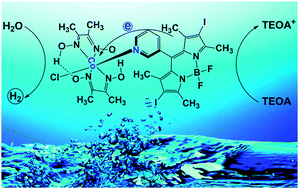Noble-metal-free BODIPY–cobaloxime photocatalysts for visible-light-driven hydrogen production†
Abstract
In this study a series of supramolecular BODIPY–cobaloxime systems Co-Bn (n = 1–4): [{Co(dmgH)2Cl}{4,4-difluoro-8-(4-pyridyl)-1,3,5,7-tetramethyl-4-bora-3a,4a-diaza-s-indacene}] (Co-B1), [{Co(dmgH)2Cl}{4,4-difluoro-8-(4-pyridyl)-1,3,5,7-tetramethyl-2,6-diiodo-4-bora-3a,4a-diaza-s-indacene}] (Co-B2), [{Co(dmgH)2Cl}{4,4-difluoro-8-(3-pyridyl)-1,3,5,7-tetramethyl-4-bora-3a,4a-diaza-s-indacene}] (Co-B3), and [{Co(dmgH)2Cl}{4,4-difluoro-8-(3-pyridyl)-1,3,5,7-tetramethyl-2,6-diiodo-4-bora-3a,4a-diaza-s-indacene}] (Co-B4) (BODIPY = boron dipyrromethene, dmgH = dimethylglyoxime) have been synthesized by replacing one axial chlorine of cobaloxime moieties with the pyridine residues of BODIPYs, and structurally characterized. Absorption spectra show that the optical properties of the BODIPY–cobaloximes are essentially the sum of their constituent components, indicating weak interactions between the cobaloxime units and BODIPY chromophores in the ground state. If any, electronic communications may take place through the intramolecular electron transfer across their orthogonal structures. The possibility of intramolecular electron transfer is further supported by the results of the density functional theory (DFT) calculations at UB3LYP/LANL2DZ levels on Co-B2˙− and Co-B4˙−, which show that the highest occupied molecular orbitals (HOMOs) possess predominantly BODIPY character, while the lowest unoccupied molecular orbitals (LUMOs) are located on the cobalt centers. The HOMO → LUMO transition is an electron-transfer process (BODIPY˙− radical anions → cobaloxime fragments). In view of the possible occurrence of electron transfer, these noble-metal-free BODIPY–cobaloximes are studied as single-component homogeneous photocatalysts for H2 generation in aqueous media. Under optimized conditions, the 2,6-diiodo BODIPY-sensitized cobaloxime Co-B4 that contains a meta-pyridyl at the 8-position of BODIPY presents excellent H2 photoproduction catalytic activity with a turnover number (TON) of 85, which is comparable to that of its analogue Co-B2 that has a para-pyridyl attached onto 2,6-diiodo BODIPY (TON = 82); however, both of the noniodinated BODIPY-sensitizer cobaloximes (Co-B1, Co-B3) exhibit a complete lack of activity under the same experimental conditions. These results show that the presence of heavy atoms in the core of BODIPY is essential for the catalytic process and reductive quenching pathways (namely, the intramolecular electron transfers from BODIPY˙− species to the cobalt centers) for these photocatalytically active systems of Co-Bn (n = 2 and 4) are thermodynamically feasible for the hydrogen-evolving reaction.


 Please wait while we load your content...
Please wait while we load your content...